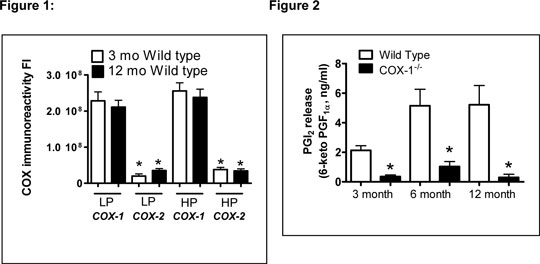Print version
Search Pub Med
COX isoforms in aortic endothelial cells from young adult and mature adult mice In the endothelium of the aorta there are athero-prone (high probability/HP) or athero-protected (low probability/LP) regions, dictated by the type of flow they experience. We have previously shown that cyclo-oxygenase (COX)-1 predominates in the endothelium of both areas in young adult mice (3 months). Debate continues regarding the levels of COX-1 versus COX-2 expression in the vasculature. Vascular function and enzyme expression changes as animals age. Thus, in the current study we have compared levels of COX-1 and COX-2 expression in HP and LP regions of aortic arch in tissue from young adult (3 month) and mature adult (12 month) C57Bl6 mice. We have also measured COX activity (as 5x10-5M A23187-stimulated prostacyclin release, 30 minutes; measured by RIA of its breakdown product, 6-ketoPGF1α) in aorta from 3, 6 and 12 month colony wild type (C57Bl6) versus COX-1 knockout (COX-1-/-) mice.

Figure 1: COX-1 immunoreactivity was high in endothelial cells of all regions of the aortic arch. COX-2 immunostaining was lower in all regions and at both ages. There was no significant (ns) difference in COX-1 or COX-2 immunoreactivity between the two age groups. Data is mean ± S.E.M for n = 8-18 images for separate regions of tissue from 6 (3mo) and 4 (12mo) mice. Data was analysed using student’s unpaired t-test. Figure 2: COX activity in aorta from 3, 6 and 12 month old wild type and COX-1-/-. Data is mean ± S.E.M for n = 4-7. Within group analysis was performed using two-way ANOVA followed by Bonferroni post-test. Significant differences were assumed were P>0.05 and denoted by*. Our results demonstrate that while both COX-1 and COX-2 are present in the endothelium of healthy young and mature mice, COX-1 immunoreactivity and activity predominates in all age groups tested.
|
|

